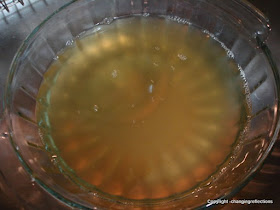After cooking up your chicken or turkey, the best part is still yet to come. Homemade broth or stock. Homemade stock is one of the best things you can make (and one of the easiest) rather than buy! My friend, Katie, at Kitchen Stewardship, has an excellent blog post on the benefits of making your own stock. Rather than re-write that here – go visit her!
The Basics: Making Stock
To make your own chicken stock/broth, you need:
- a large kettle or crockpot
- a chicken or turkey carcass {bones, skin & any tiny meat pieces leftover}
- a whole onion
- 2-3 stalks of celery
- 2-3 carrots
- 1-2 bay leaves
- 4-5 garlic cloves
- sea salt
- black pepper
- white vinegar
- water
- a strainer, preferably with fine mesh
- time
Making your own chicken stock
(1) Place the chicken carcass – bones, skin {if desired} and any meat still attached to the bone (small pieces are fine, but you should take all the large pieces off the bones before you make stock) into a large stockpot or crockpot.
(2) Toss in one onion, cut into sections, carrots and celery.
(3) Add the water, enough to fill the crockpot or stockpot.
(4) Add in the garlic, bay leaf and sea salt. Be liberal with the sea salt.
(5) Add a splash of vinegar – this works to really help break down the bones & get them to release their nutrients.
(6) Cover the crockpot and cook on low for 12-18 hours. I do this overnight. If you are cooking on the stove, cook on low/simmer, for 4-8 hours.
(7) Strain the broth through a large strainer or colander to remove the bones, skin and veggies. Some folks puree their stock in the blender with the veggies … I haven’t tried that just yet.
(8) Place the broth into freezer safe containers. Allowing the broth to cool down quite a bit, then, transfer the broth to the fridge for a few hours.
At this point, you can either toss your bones, or you can repeat the cycle, boiling them a second time. This broth is less strong, but you can easily up the veggies as though you were making veggie broth, and you have a second batch!
(9) If you wish, after the broth cools, the fat will rise to the surface. Simply take a spoon and scoop the fat off the top. Then, transfer your broth to the freezer, or use with a day or two.
Storing Broth
If you plan on using your broth right away, store it in the fridge for 1-2 days. If not, place the broth in the freezer, where it will keep for up to three months.
The easiest way to store it is to portion it out into soup quantities (4+ cups), or other quantities (e.g., 1 C) for casseroles or other recipes.
I tried making homemade broth, but the flavor wasn’t excellent, what did I do wrong?
This happens from time to time, and by practicing making broth, you’ll get better. But, here are a couple of tips to help you out.
First – be sure to add enough salt. This is often my problem – I don’t add enough salt to the broth, so it just tastes watery and bland.
Second – try adding the veggies later in the cooking process; 6 hours or so in if you are trying the crockpot method. This will help the veggies to release their excellent flavor, but will not be over cooked.
Third – boil the stock with the cover off for about 45 minutes to “condense” it a little more, ridding the stock of extra water. This will concentrate the flavors.
Uses for Homemade Chicken Stock
Our favorite way to use homemade broth is in soups…
 |  |  |
But, we also cook our rice in it (extra yummy), use it in casserole dishes that call for chicken stock, and use it to make homemade cream of chicken & mushroom soup.
So… will you give homemade stock a try? Do you already make your own?
Linked to: Kitchen Tip Tuesday, Tasty Tuesday


![[DSC04887.JPG]](https://blogger.googleusercontent.com/img/b/R29vZ2xl/AVvXsEjQS93WB2TkjlQBzRC-NjvQLp029ZFyIkQz8EIRU6WBn8aKUF5cAjc3lDhLR53qXHygregiTmWW0HqU9FYSQzR1PsHbUdncgg39kBBIEhl65YZTD5kpaBXMZzFm-a2xGAYPTRRm4LpWHjRs/s280/DSC04887.JPG)



Homemade stock is something I would not live with out :) It's so easy and delicious and literally made with scraps. LOVE THAT! Never tried adding vinegar to the water, I'll give that a shot next time.
ReplyDeleteSo funny you posted this today...I was just getting a post together for my blog about homemade broth! :) I tend to leave out the salt in mine (I salt the bird, but usually don't add extra to make the broth because I add salt on an as-needed basis to the meals I cook with the broth (soups, casseroles, etc.) Maybe I should add salt in next time to the broth!
ReplyDeleteBecause of my allergy I HAVE to make all of my stock/broth homemade. I had never heard about the vinegar...may have to try that next time. Thanks!
ReplyDeleteI love this series you're doing! I have made my own stock - nothing compares to it flavor wise. Thanks for all the great tips! And for your e-mail - I'll get back to you soon - I love the idea!
ReplyDeleteI never realized that I could allow the stock to "condense" to increase its flavor! The bland, watery taste has always discouraged me from making my own stock. Thanks for sharing!
ReplyDeleteThank you also for taking time to visit Contented at Home!
Very informative post. I had a chicken carcass simmering overnight. Using vinegar is a new idea, I will try it next time. My son, who is a chef, tells me to use 50% carrots, 25% onions and 25% celery.
ReplyDeleteThank you.
What a great tip! Thanks for passing on this knowledge to us.
Delete